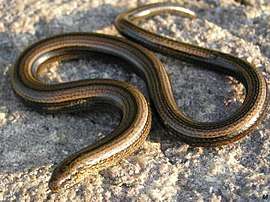Anguimorpha
| Anguimorphs | |
|---|---|
 | |
| Scientific classification | |
| Kingdom: | Animalia |
| Phylum: | Chordata |
| Class: | Reptilia |
| Order: | Squamata |
| Clade: | Toxicofera |
| Suborder: | Anguimorpha Fürbringer, 1900 |
| Subclades | |
Anguimorphs of the infraorder Anguimorpha include the anguids (alligator lizards, glass lizards, galliwasps and legless lizards). The infraorder was named by Fürbringer in 1900 to include all autarchoglossans closer to Varanus and Anguis than Scincus. These lizards, along with iguanians and snakes, constitute the proposed "venom clade" Toxicofera of all venomous reptiles.[1]
Families
Anguidae
There are 9 genera found within the Anguidae family. They are characterized by being heavily armored with non-overlapping scales, and almost all having well-developed ventrolateral folds (excluding Anguis). Anguidae members can, however, be somewhat difficult to identify in their family, as members can be limbed or limbless, and can be both viviparous and oviparous.
Anniellidae
There is only one genus within the Anniellidae family, comprising 6 species of American legless lizards. They are characterized as having no limbs, an can be found in California and Baja California. They have wedge shaped heads and a countersunk jaw that allow them to bury themselves in sand or loose soil. They give live birth and usually have two offspring
Diploglossidae
There are three genera in the Diploglossidae family. They are characterized by having very long, autotomized tails, and no ventrolateral fold. They give both live birth, and lay clutches, according to the genus.
Xenosauridae
There is only once genus, with 6 species, found in the Xenosauridae family. This family is both dorsally and ventrally covered in knob-like scales. Their tail is about 1.2 times the length of their body. They give live birth, with a litter usually consisting of two offspring.
Helodermatidae
The family Helodermatidae (beaded lizards) has only one genus with 5 species, incluing the Gila monster. This family is the only know family of lizards that have well-developed venom glands. They have somewhat tubercular scales both dorsally and laterally, with their ventral scales being smooth , and being larger than the dorsal and lateral scales. They are oviparous, with clutch sizes averaging about 6 eggs per clutch.
Shinisauridae
The family of Shinisauridae is only made up of once species, Shinisaurus crocodilurus, the Chinese crocodile lizard. This species is semiaquatic, found in forests along streams. Found in southern China, this species is viviparous, with litters ranging from 2-7 individuals. This species has well developed limbs, and has a tail that is around 1.2 times the length of its body.
Lanthanotidae
The family Lanthanotidae consists of a single species, the earless monitor lizard (Lanthanotus borneensis). This species has thick skin, which is covered by small, rounded scales. The main defining feature that distinguishes this species from other monitors is its lack of a parietal eye and the lack of a hemibaculum. The species is presumed to be semiaquatic, but little is known about its wild habits, as most information and study comes from captive individuals.
Varanidae
The Varanidae are a family of carnivorous and frugivorous monitor lizards, which contains one extant genus (Varanus) with 73 species, including the Komodo dragon. They can be characterized by their thick skin and small, rounded scales. The ventral scales are slightly larger than the dorsal scales. They have a parietal eye and a hemibaculum. This oviparous family has a clutch size that correlates with the body size. They also have limbs that are relatively small for their body size. The family is also broken up into 9 distinct morphological subgroups.
References
- ↑ Fry, B.; et al. (February 2006). "Early evolution of the venom system in lizards and snakes" (PDF). Nature. 439 (7076): 584–588. doi:10.1038/nature04328. PMID 16292255.